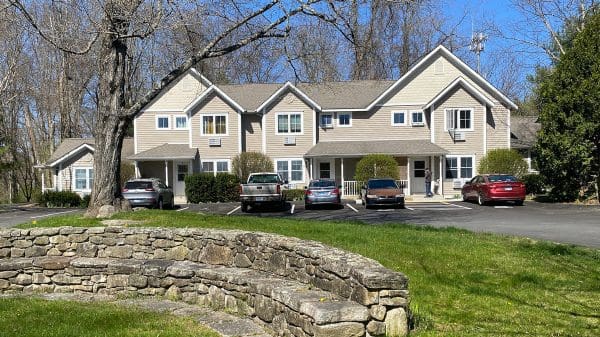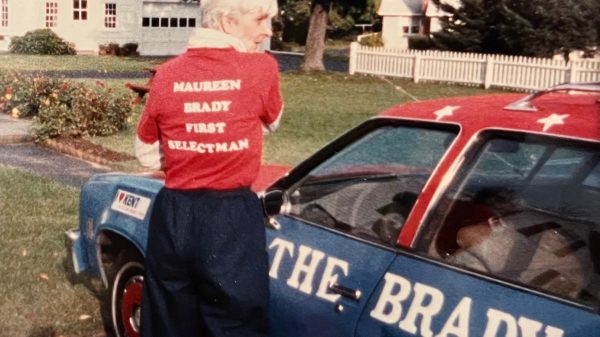KENT—While the Eric Sloane Museum was ringing bells in joyous commemoration of the nation’s founding, Kent residents were also pausing to celebrate the achievement of a local sculptor who created an epic monument to the valor of World War I veterans.

Sabin Howard recently completed a “A Soldier’s Story,” a 58-foot-long, 38-figure frieze that will be unveiled Sept. 13 in Pershing Park in Washington, D.C. It is the last of the United States’ four major 20th-century wars to receive a memorial in the nation’s capitol.
Howard was feted Saturday night by the Kent Memorial Library; the Kent American Legion, Post 153; the Roger Sherman Chapter of the DAR, which provided an expansive buffet; the Kent Art Association and the Kent Historical Society.

The Community House was filled to capacity. Before the program began, residents took in a display of World War I artifacts and learned that Howard is not the first internationally renowned Kent artist to memorialize the horrors of The Great War. Sixty-seven names of Kent men are inscribed on a bronze plaque by acclaimed sculptor Willard Dryden Paddock, a Kent resident from 1912 to 1956. The plaque is displayed over the mantel at the Kent Memorial Library, which was, in itself, built as a memorial to local veterans, three of whom died in the war.
Paddock was also commissioned to create the base of the World War I memorial flagpole at the Pratt institute in Brooklyn, N.Y., and a second monument to peace in Stratford. He used his nieces, Mary and Kate Steichen, daughters of the famed photographer Edward Steichen, as models for those sculptures.

In a direct parallel, Sabin Howard used his daughter, Madeleine, as the model for the first and last sculptures in his paean to the veterans’ heroism.
In his talk, Howard said that his involvement in the project—which involved three years of bureaucratic frustration dealing with Washington commissions, followed by five years of intense labor and innovation to meet his deadline—elevated his art.
“I had never done a multi-figure composition before this. You couldn’t go to the bookstore and get a book on how to approach it—there was no ‘How to Make Monuments for Dummies’—but there is no limit to the possibilities of what you can do. I had to go experience it as a human being.

“This is a strong statement about why people matter, about rising to the occasion,” he continued. “I had to change my way of working. I was a classicist, but here I had to do something the average Joe going to Washington would understand, that would hit him in the chest. What I am doing with this project is not done anymore. It’s a radical, rebellious work of art.”
He predicts that when it is unveiled in September, it will have “a radical impact on the world of art.” And that is just what he wants.
“I have been in a fight against modernism since I started as an artist,” he told his audience. He explained that he was born in New York City but taken to Italy when he was three months old. “Italy is different visually, it’s an ancient culture with a vision of splendor to it. If you grow up around that, it has a big impact on how you perceive things,” he said.
He became steeped in the art of Michelangelo and Leonardo da Vinci, but there were other influences as well. “In the 60’s, my parents were heavily involved in the anti-war movement, and they dragged me along to anti-war protests. I’m very anti-war. I was given the task of making a memorial to commemorate a horrible, meat-grinding war and I made it about healing. I made something that talks about the human heart, of belonging to something bigger than yourself.”
There is irony in that, as he observes that “what happened at the end of World War I marked the end of the idea that the world is divinely ordered,” and set the stage for the modernism he loathes.
The sheer size of the sculpture—25 tons, 58-feet long, 38 figures—ensures its iconic status, but the story it tells is also an allegory for heroism. “Those are just the facts,” Howard said. “The important thing is the story about human beings. The first scene is of the family, with the daughter handing a helmet to her father. In the next scene, he is caught between the mother and the call to something greater. The middle depicts the cost of war, followed by the shell-shocked veteran. The end is the transformation, with the soldier, changed forever, returning to his family and handing his helmet to his daughter—the next generation.”

He noted that he used local veteran Chris Rehnberg to model the head of the shell-shocked veteran. “After the battle scene, college boys didn’t work anymore as models,” he said. He turned to veterans, finding in their morphology the vestiges of their experiences. “I couldn’t do it without someone who had experienced battle and war.”
He chose models from all walks of life, “just like the veterans who went off to fight.”
“Their blood was one color; they were all Americans. I didn’t do that because it was the correct political thing to do, but because I wanted to make a great work of art. The biggest thing I took from this is the noble act of sacrifice.”
The sculpture is currently at sea, coming to the United States from a foundry in England where it was transformed from his models to finished panels. Once in Washington, the four panels will be welded in place and readied for their unveiling.


























